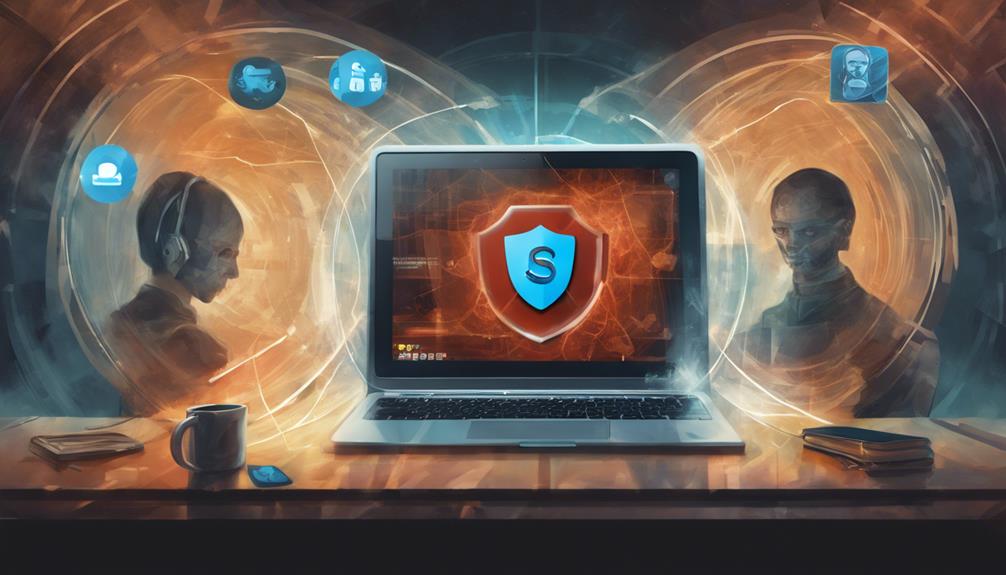Skype is particularly secure against hackers due to its robust encryption methods, such as end-to-end encryption with 256-bit AES, coupled with continual protocol enhancements. The platform regularly updates its security measures, like patches and bug fixes, strengthening its defenses. Users can also manage their data securely through privacy settings and control features. Additional protection layers are offered through Multi-factor Authentication (MFA) and Two-Factor Authentication (2FA). Additionally, monitoring tools assist users in detecting unauthorized access and suspicious activities. By following best practices like using unique passwords and being vigilant against phishing, users can ensure a safer Skype experience.
Key Takeaways
- Skype employs robust 256-bit AES encryption.
- Continuous security protocol upgrades enhance protection.
- Regular updates, patches, and bug fixes bolster platform security.
- Privacy settings and data control features empower users.
- Multi-factor authentication and monitoring tools enhance account security.
Encryption Measures in Skype
Skype implements robust encryption measures across its platform to guarantee the privacy and security of user communications. By offering end-to-end encryption for calls, messages, and file transfers, Skype assures that sensitive data remains protected from unauthorized access. This encryption method means that only the sender and recipient have the ability to decrypt the information, enhancing both privacy and security.
The use of 256-bit Advanced Encryption Standard (AES) by Skype further solidifies the security of user communications, providing a high level of protection against potential cyber threats. Additionally, Skype continuously engages in protocol upgrades to enhance its encryption mechanisms, ensuring that they remain resilient against evolving cybersecurity challenges.
The implementation of encryption in Skype not only promotes secure communication practices online but also helps safeguard confidential conversations and data exchanged through the platform.
Multi-factor Authentication (MFA)

When enhancing account security in online communication platforms, one effective method is the implementation of Multi-factor Authentication (MFA). MFA adds an extra layer of security by requiring users to provide multiple forms of verification, such as a code from their phone or email, in addition to their password.
In the case of Skype, enabling MFA enhances account security beyond just passwords, markedly reducing the risk of unauthorized access by hackers. By incorporating MFA, users can strengthen the security of their Skype accounts and decrease the likelihood of falling victim to hacking attempts.
It is considered a best practice to enable Multi-factor Authentication on Skype to safeguard personal information and communications from potential security breaches. By requiring multiple steps for verification, MFA serves as a robust defense mechanism against unauthorized access, making it an essential tool in maintaining the integrity and privacy of online communication platforms.
Regular Security Protocol Updates

Skype's commitment to providing regular security protocol updates underscores its dedication to safeguarding user information from potential cyber threats.
These updates involve deploying patches and bug fixes to fortify the platform against emerging vulnerabilities, ensuring a secure communication environment for all users.
Frequent Software Updates
Regular software updates play an essential role in enhancing the security measures of communication platforms like Skype. These updates are vital in addressing security vulnerabilities, strengthening encryption, and protecting user data from potential hacking attempts.
By consistently rolling out security updates, Skype can mitigate risks and provide a secure environment for its users. These software updates not only patch existing security flaws but also incorporate the latest security features to prevent unauthorized access and security breaches.
Through the deployment of regular patches and updates, Skype demonstrates its commitment to safeguarding user data and maintaining a secure platform for communication. Staying current with these updates is paramount for users to benefit from the ongoing improvements and make sure that their interactions on Skype remain protected from potential cyber threats.
Ongoing Security Enhancements
Implementing ongoing security enhancements through regular updates is an essential aspect of maintaining the integrity and protection of communication platforms like Skype. By consistently updating security protocols, Skype aims to enhance its platform defenses against emerging threats and potential vulnerabilities. These security updates play a crucial role in safeguarding users' data and ensuring secure communication experiences. Continuous improvements in defense mechanisms help mitigate risks posed by hackers and strengthen the overall protection of the platform. Through these ongoing enhancements, Skype demonstrates its commitment to providing a safe and reliable environment for its users.
| Security Updates | Enhancements | Protection |
|---|---|---|
| Emerging Threats | Vulnerabilities | Defense Mechanisms |
| Hackers | Security Protocols | Secure Communication |
Privacy Settings and Data Control

Users can take advantage of Skype's robust privacy settings and data control features to protect their communication and personal information. With end-to-end encryption in place for calls, texts, and file transfers, Skype guarantees secure communication, safeguarding users from potential eavesdropping or data breaches.
By managing privacy settings, users can control who can contact them and access their profile information, enhancing their overall privacy control. Additionally, the option to delete chat history adds an extra layer of security, allowing users to maintain confidentiality in their conversations.
These privacy options not only offer users peace of mind but also empower them to engage in confidential discussions without concerns about unauthorized access. With programmable privacy settings and secure features like end-to-end encryption and chat history deletion, Skype provides a platform where users can communicate safely and maintain control over their personal data.
Account Security Enhancements

In addition, Skype has implemented Two-Factor Authentication (2FA) to provide an additional layer of security to users' accounts. This feature requires users to verify their identity using two different methods, enhancing protection against unauthorized access.
Users are also encouraged to maintain strong, unique passwords and monitor their account activity closely to detect any suspicious behavior promptly.
Two-Factor Authentication
Enhancing account security on Skype, two-factor authentication provides an additional layer of protection against unauthorized access. By requiring an additional verification method beyond passwords, this security enhancement greatly reduces the risk of hackers gaining access to Skype accounts.
Users can easily enable two-factor authentication in their Skype settings to strengthen their account security. This feature is vital in safeguarding Skype accounts from potential hacking attempts, as it guarantees that even if hackers acquire the password, they would still need the second form of verification to access the account.
Password Strength Requirements
To bolster the security of Skype accounts, adhering to stringent password strength requirements is paramount. Strong passwords are crucial in preventing unauthorized access by hackers. Skype recommends creating unique passwords that include a mix of letters, numbers, and special characters to enhance account security. Avoid using common words or personal information that can be easily guessed. Longer passwords are preferred as they increase complexity, making it harder for hackers to crack them. Regularly changing passwords is also advised to mitigate the risk of unauthorized access to Skype accounts. Utilizing a password manager can assist users in generating and securely storing complex passwords, further enhancing account protection.
| Password Strength Tips | Benefits |
|---|---|
| Use a mix of characters | Increased complexity |
| Avoid common words | Prevent easy guessing |
| Regularly change passwords | Mitigate unauthorized access risk |
| Utilize a password manager | Securely store complex passwords |
| Opt for longer passwords | Harder for hackers to crack |
Account Activity Monitoring
Monitoring account activity is an essential approach to enhancing the security of Skype accounts and safeguarding against unauthorized access and suspicious behavior. By consistently monitoring login history, recent activity, and connected devices, users can gain valuable insights into potential security breaches.
Additionally, keeping an eye on changes in the contact list, message history, and unexpected login locations can help identify security threats before they escalate. Setting up account alerts for unusual login attempts or modifications further strengthens the security of Skype accounts.
Promptly reviewing and addressing any irregularities in account activity is vital in preventing potential hacker access. This thorough monitoring system empowers users to protect their data and maintain secure communication channels on Skype.
Minimizing Hacker Risks

One effective approach to safeguarding your Skype account from potential hackers is by implementing proactive measures to minimize security risks.
Firstly, make sure you use strong, unique passwords and enable two-factor authentication to add an extra layer of protection.
Regularly updating your Skype software is essential to installing the latest security patches and bug fixes, reducing vulnerabilities that hackers could exploit.
Be vigilant against phishing emails and suspicious links that may lead to unauthorized access to your account.
Monitoring your account activity is vital to detect any signs of unauthorized entry promptly.
Additionally, adjusting your privacy settings on Skype can help control who can contact you and view your profile information, decreasing the likelihood of being targeted by hackers.
Frequently Asked Questions
Can Someone Steal Your Info Through Skype?
Yes, personal information can be stolen through Skype. Hackers exploit vulnerabilities or use phishing techniques to target user data like contact lists, chat history, and call details. Vigilance and adherence to security practices are essential to prevent data theft.
Can Skype Get Hacked?
Exploring the digital landscape presents risks, and Skype is not immune to hacking. Vigilance against cyber threats is essential. Employ robust security practices, such as strong passwords, software updates, and utilizing available features like two-factor authentication, to safeguard your Skype account.
Can Skype Be Trusted?
Skype can be trusted due to its robust security measures, including end-to-end encryption, regular updates, multi-factor authentication, and user-controlled privacy settings. Transparency reports on government data requests also foster trust and compliance with privacy laws.
Are There Security Issues With Skype?
Security issues with Skype persist, encompassing vulnerabilities from phishing attacks, malware, and weak user practices. To fortify protection, users should adhere to stringent password policies, employ two-factor authentication, and remain vigilant against phishing threats.
Conclusion
To sum up, Skype employs robust encryption measures, multi-factor authentication, regular security updates, privacy settings, and account security enhancements to minimize the risks of hacking.
As the saying goes, 'an ounce of prevention is worth a pound of cure,' and Skype's proactive approach to security measures aims to keep users' information safe and secure.









